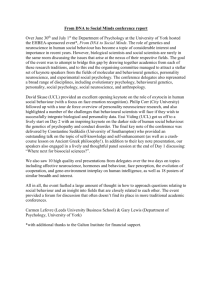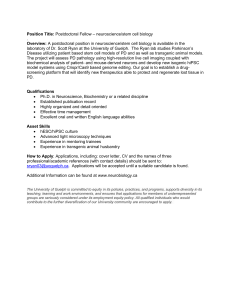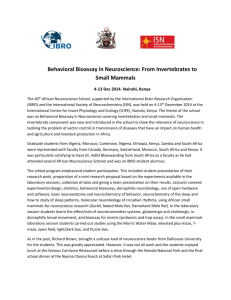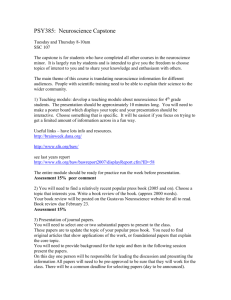doc - Neurowissenschaftliche Gesellschaft eV
advertisement
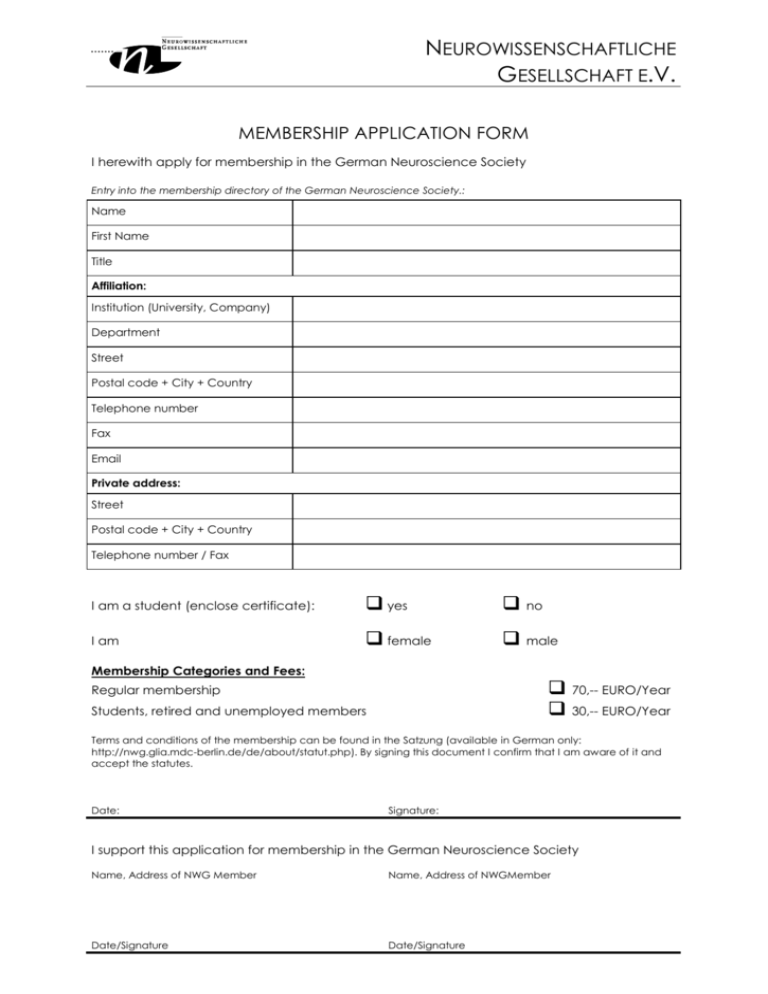
NEUROWISSENSCHAFTLICHE GESELLSCHAFT E.V. MEMBERSHIP APPLICATION FORM I herewith apply for membership in the German Neuroscience Society Entry into the membership directory of the German Neuroscience Society.: Name First Name Title Affiliation: Institution (University, Company) Department Street Postal code + City + Country Telephone number Fax Email Private address: Street Postal code + City + Country Telephone number / Fax I am a student (enclose certificate): yes no I am female male Membership Categories and Fees: 70,-- EURO/Year 30,-- EURO/Year Regular membership Students, retired and unemployed members Terms and conditions of the membership can be found in the Satzung (available in German only: http://nwg.glia.mdc-berlin.de/de/about/statut.php). By signing this document I confirm that I am aware of it and accept the statutes. Date: Signature: I support this application for membership in the German Neuroscience Society Name, Address of NWG Member Name, Address of NWGMember Date/Signature Date/Signature NEUROWISSENSCHAFTLICHE GESELLSCHAFT E.V. MEMBERSHIP APPLICATION FORM I choose the following -two- sections (check accordingly): Cognitive Neuroscience Computational Neuroscience Developmental Neurobiology und Neurogenetics Clinical Neuroscience Molecular Neurobiology Neuropharmacology and -toxicology Systems Neurobiology Behavioural Neurobiology Cellular Neurobiology My area of work involves the following fields (please choose no more then five topics from the list below and fill in the numbers): Further: 1. 2. 3. 4. 5. My spectrum of methods involves the following fields (please choose no more then five topics from the list below and fill in the numbers): Further: 1. 2. 3. 4. 5. I don’t agree with the use of any data for scientific information processing. Please send your application to: or send it via fax to: Neurowissenschaftliche Gesellschaft e.V. Meino Alexandra Gibson Zelluläre Neurowissenschaften Max-Delbrück-Centrum für Molekulare Medizin Robert-Rössle-Str. 10 13092 Berlin +49 30 9406 2813 NEUROWISSENSCHAFTLICHE GESELLSCHAFT E.V. Payment Annual Fee: Regular Member Students, retired and unemployed Members 70,-- EURO/Year 30,-- EURO/Year SEPA Direct Debit Mandate Creditor identifier of the GNS: DE64NWG00001110437 I authorise the German Neuroscience Society to withdraw the annual membership fee of 70,-- EURO/Year 30,-- EURO/Year. from the following German bank account: IBAN: ___________________________________________________________________ Name of Bank: ____________________________________________________________________ BIC/SWIFT Code: ___________________________________________________________________ Furthermore I inform my bank to debit my account in accordance with the instructions from the GNS. Place, Date: Signature: _____ Account holder (Name, first name): ______________________________________________________ Address: ________________________________________________________________________________ Payment via VISA-Card or Euro-/Mastercard Card number: (These are the sixteen digits on the front of your credit card) Exp. Date: / (These are the three digits on the back of the card) Name of the card holder: _________________________________ Amount: ___________ EURO Signature: _________________________________ Bank Transfer Correspondent bank: Berliner Bank AG, IBAN: DE55 1007 0848 0463 8664 05 BIC (SWIFT-CODE): DEUTDEDB110 Send to: by Fax: Neurowissenschaftliche Gesellschaft e.V. Meino Gibson Max-Delbrück-Centrum für Molekulare Medizin Robert-Rössle-Str. 10 13092 Berlin +49 30 9406 2813 Topics Please choose no more then five topics from the list below and fill in the numbers to the form: Development and Plasticity 1 cell proliferation and lineage 2 cell migration 3 cell determination and differentiation 4 process outgrowth 5 trophic agents 6 (neuro)trophic factors 7 substrates, ECM, cell adhesion molecules 8 synaptogenesis 9 regressive events in neural development 10 endocrine control and development 11 nutritional and prenatal factors 12 plasticity in adult animals 13 regeneration and sprouting 14 transplantations 15 developmental disorders 16 regional and system development 17 ageing 63 64 65 66 Cell Biology 18 apoptosis, cell death 19 gene structure and function 20 regulation of gene expression 21 peptide and protein processing and sorting 22 membrane composition and cell-surface macromolecules 23 cytoskeleton, axonal transport 24 neuroglia and myelin 25 blood-brain barrier 26 neuroimmunology 27 staining and tracing techniques 28 protein chemistry 29 second messenger pathways Other Systems of the CNS 79 limbic system 80 hypothalamus 81 hippocampus and amygdala 82 association cortex 83 brain stem systems 84 comparative neuroanatomy 85 brain of invertebrates 86 ventral cord of invertebrates Excitable Membranes and Synaptic Transmission 30 synaptic structure and function 31 presynaptic mechanisms 32 postsynaptic mechanisms 33 pharmacology of synaptic transmission 34 ion channels 35 ion channels modulation and regulation 36 functional synaptic plasticity Neurotransmitters, Modulators and Receptors 37 free radicals 38 (anti) oxidants 39 acetylcholine, cholinergic receptors 40 excitatory amino acids and their receptors 41 amino acids, GABA, benzodiazepines and receptors 42 peptides 43 opioids 44 catecholamines and their receptors 45 uptake, storage, secretion and metabolism 46 interactions between neurotransmitters, 47 co-transmission, co-localisation 48 regional localisation of receptors and transmitters 49 behavioural pharmacology 50 nucleotides and their receptors 51 other neuroactive substances (e.g. NO, adenosine) 52 serotonin and its receptors Neuroendocrine and Autonomic Regulation 53 neuroendocrine control 54 regulation of autonomic and cardiovascular functions 55 biological rhythms and sleep 56 brain metabolism Sensory Systems 57 somatic and visceral afferents 58 spinal cord 59 somatosensory pathways and cortex 60 sensory ganglia 61 pain 62 retina and photoreceptors visual pathways and cortex auditory systems chemical senses invertebrate sensory systems Motor Systems and Sensorimotor Integration 67 cortex 68 basal ganglia 69 thalamus 70 cerebellum 71 vestibular system 72 oculomotor system 73 reflex function 74 spinal cord and brainstem 75 control of posture and movement 76 circuitry and pattern generation 77 invertebrate motor function 78 muscle Behaviour 87 human behavioural neurobiology 88 brain function and language 89 interhemispheric relations lateralisation 90 transgenic/gene knockout animals and behaviour 91 learning and memory 92 spatial cognition 93 motivation and emotion 94 neuroethology 95 invertebrate learning and behaviour 96 feeding and drinking 97 hormonal control of behaviour 98 monoamines and behaviour 99 neuropeptides and behaviour 100 drugs of abuse 101 psychotherapeutic drugs 102 behavioural aspects of ageing 103 invertebrate sensory systems 104 invertebrate motor systems Disorders of the Nervous System 105 genetic models 106 epilepsy 107 Alzheimer's 108 Parkinson's 109 Huntington's 110 degenerative disease others 111 ischemia/hypoxia 112 cerebrovascular diseases 113 tumors 114 neuromuscular diseases 115 motor neuron diseases 116 neuropathy 117 neuroprotection 118 behavioural disorders 119 neurotoxicity 120 neural protheses 121 clinical neurophysiology 122 psychosis 123 anxiety disorders Computational Approaches 124 neural networks 125 artificial intelligence Methods Please choose no more then five methods from the list below and fill in the numbers to the form: Neuroanatomical Methods 1 histological techniques 2 in situ hybridization 3 receptor binding techniques 4 tracing techniques 5 immunocytochemistry 6 electron microscopy/immunoelectron microscopy 7 intracellular marking Neurophysiology 34 use of brain slices 35 acute isolation of neural cells 36 extracellular recording techniques 37 intracellular recording techniques sharp microelectrodes 38 patch-clamp recording 39 imaging nervous system activity 40 recording from behaving animals 41 recording from whole brains/ganglia Cellular and Developmental Neuroscience 8 cell culture techniques 9 organotypic tissue culture 10 neuronal cell culture 11 glial cell culture 12 immortalizing central nervous system cells 13 techniques to measure cell prolifaration, necrosis and apoptosis 14 experimental transplantation Neurochemistry/Neuropharmacology 42 microdialysis 43 analyzing radioligand binding data 44 ligand characterization using microphysiometry 45 uptake and release of neurotransmitters 46 optical uncaging of comounds 47 analysis of brain metabolism 48 protein chemistry 49 peptide sequencing 50 ELISA 51 systemic or local manipulation of brain functions Gene Cloning, Expression and Mutagenesis 15 PCR 16 cloning of neural gene products 17 interaction trap/two-hybrid system to identify interacting proteins 18 transient expression of proteins 19 mutagenesis approaches to study protein structure-function relationship 20 Gene targeting 21 Transgenic animals Molecular Neuroscience 22 RNA analyses by nuclease protection 23 reducing gene expression in the brain via antisense methods 24 production of antibodies 25 epitope tagging of recombinant proteins 26 transcriptome analysis (DD-PCR, CHIPS, SAGE) 27 hyperexpression of proteins in situ 28 deletion of genes (knockout techniques) 29 proteomanalysis (2-D gel electrophoresis) 30 Knock-out methodology 31 germline transgenic methodology 32 somatic transgenic methodology 33 protein chemistry with Behavioral Neuroscince 52 EMGs. EEGSs, recording of locomotory activity 53 locomotor behavior 54 sexual and reproductive behavior 55 animal tests of anxiety 56 learning and memory 57 measures of food intake and ingestive behaviour 58 methods of behavioral pharmacology 59 methods of behavioral physiology 60 sensory and perceptual physiology 61 psychophysics 62 navigation and orientation 63 choice strategies and optimization of behavior Clinical Neuroscience 64 PET 65 MRI 66 DOPPLER 67 MEG 68 EEG 69 evoked potentials 70 CSF-analysis 71 animal models for diseases

